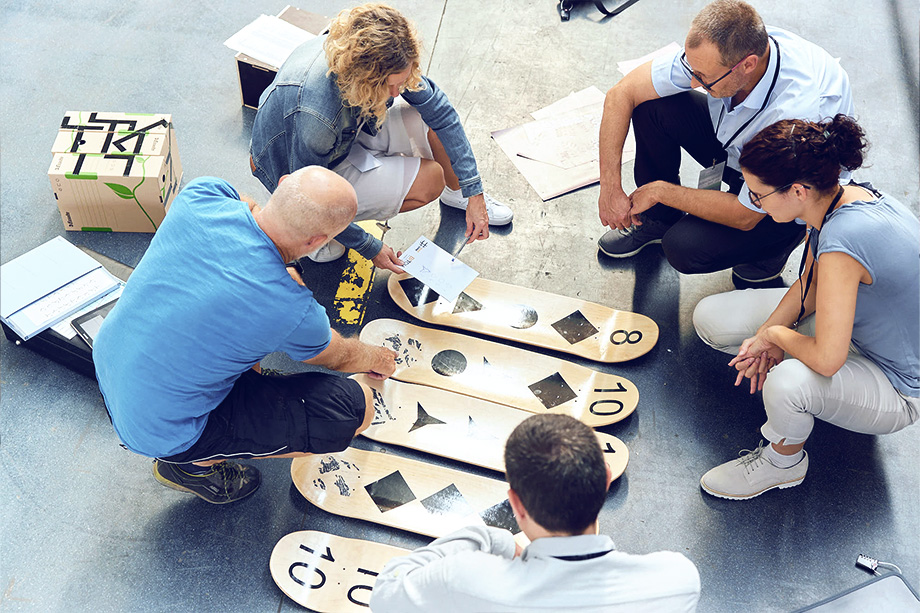Team building should be fun! Collective laughing, tinkering, puzzling, going together on a journey and upon return patting each other on the back: all this is definitely part of a team event team event or a company trip. You get this at BITOU – and a lot more: we want your team building to have a lasting effect! Those who are in a good mood work more effectively. This is why we give exciting, creative and thoughtful impulses to the team with our team events, with which you can improve your everyday working life long term. In this way, a win-win situation arises: the colleagues develop more fun when working together and the company receives more successful teams. Those who are in a good mood work more effectively. This is why we give exciting, creative and thoughtful impulses to the team with our team events, with which you can improve your everyday working life long term. In this way, a win-win situation arises: the colleagues develop more fun when working together and the company receives more successful teams.

Those who are in a good mood work more effectively. This is why we give exciting, creative and thoughtful impulses to the team with our team events, with which you can improve your everyday working life long term. In this way, a win-win situation arises: the colleagues develop more fun when working together and the company receives more successful teams.
Team building refers to all measures that are designed to improve interpersonal relationships within a team – with the aim of improving its productivity. Team events often use activating, entertaining stimuli and tasks are solved together. This makes the strengths of each individual visible – and a phase of reflection can follow on from this.

Building trust, problem-solving or decision-making, communication, adaptability and planning: these four subject areas can be worked on particularly well as part of a team-building measure. In the run-up to your team event, we will be happy to advise you individually on your objectives and suggest suitable measures for you.

Personality tests and personality analyses have long been used in the HR sector to put together teams in a more targeted manner. But what are the strengths and weaknesses of existing teams? Here, for example, it makes sense to carry out an analysis of the team’s dysfunctions (according to Lencioni) in order to find out exactly what the team needs in terms of intervention in order to work better together. Start the online analysis with BITOU today.
Furthermore, the roles of team members within existing teams or when putting together new teams can also be determined through targeted analysis. The aim here is not to impose a role on a person, but to find out what this person really enjoys doing and to use this intrinsic motivation in teamwork.
Team performance can be measured and compared. For example, an actual situation and the increase in team performance can be measured during a team building process or the improvement in team performance over a period of time.
Similarly, a comparison of the scores of other teams can be used to assess team performance in the company or in the same sector in an international and national comparison. In other words, a real benchmark that has been established by running the simulation several times. The degree of cooperation and silo thinking, the degree of communication and the handling of resources and willingness to take risks are measured.
The classics of team building such as raft building, soapbox building and geocaching have become outdated. Although they are often fun, they offer little added value for the further development of the team. The newer team building programs of recent years, such as escape games and chain reactions, already offer much more variance or promote thinking in the big picture, so they already offer much more benefit for team building in addition to the fun, which is a basic requirement of team building.
It is also not about testing the teams’ knowledge about the company, as in an assessment center, but about generating added value for teamwork. The future lies in team building that also makes the team’s status and progress measurable and transparent. This increases the motivation of team members and makes teamwork much more targeted and therefore more effective.

Teambuilding can be differentiated into “downward” and “upward”: We distinguish between “Teambonding”, “Teambuilding”, and “Teamtraining”. The differences lie in the degree of intensity with which challenges and problems are worked on in the team.
When it comes to so-called “Teambonding”, the focus is clearly on free, relaxed interaction through shared experiences. There are no reflection sessions or specific tasks. The goal is to strengthen the sense of unity and togetherness. This can be achieved very well, for example, through a soapbox derby, an online quiz, or a geocaching tour in the great outdoors.
When we talk about “Teamtraining”, we mean working intensively on questions of collaboration. For example, a team is transitioning to digital work and wants to find out how to make collaboration and communication work for them. What roles are needed in the team? How and where are information exchanged? Or there is a conflict within the team that needs to be resolved through moderated exchange. Both situations require an intensive examination that goes beyond classic team building.
When it comes to classic team building, we alternate between entertainment, challenge, and reflection. Our team events are designed so that every character in the team can contribute well. This way, team members can gradually explore their roles in the team.
That a team must work in the same four walls is a long outdated assumption. And also, that physical proximity automatically welds together. Many teams work together remotely, whether in the classic home office or as a modern remote concept distributed all over the world. BITOU is your expert to create a close bond even between those team members who hardly meet personally in everyday work life. Online team building is the keyword: With virtual team building events that can be completed both simultaneously and time-shifted, employees get to know each other and work together efficiently – if desired, also with high entertainment value! Examples:
To ensure that your team building is a complete success, it is worth relying on a provider for whom fun is not the only important thing. BITOU focuses on memorable and original team events and developments that bring your employees together and give them valuable learnings along the way.

Teambuilding brings colleagues together and creates memories. However, for successful team building events, several things should be considered.
By the way, in a survey of our LinkedIn contacts, 52% of respondents said that regular team building measures increase job satisfaction. 29% of respondents even said that job satisfaction is significantly increased.
In addition to the activities, it is important to think about the budget, the participants, and the location. The team-building measures should also be tailored to the participants so that everyone is included and no one feels excluded.
We have summarized the most important points again:
There are different reasons for carrying out a team building measure, such as better getting to know each other in the team, increasing motivation, rewarding special achievements, project completion, kick-off, formation of new teams… From the variety of different motives alone, it can be seen that it is important to choose the “right” one from the multitude of ideas. Use our event finder or activity filter in our team developments, for example, to do so
When selecting the right team building event, the participants are also of crucial importance. A group of technical employees can be inspired by different events than a team from accounting. Are all participants athletic or are there handicapped participants? Are the participants experienced in handling digital tools and what is the age structure? BITOU has 20 years of experience in team building and we are happy to advise you
How many articipants are involved in team building activities? A chain reaction, for example, is ideal for groups of several hundred to even 5000 participants. Escape rooms are usually designed for small groups of up to 100 participants. You can make an initial selection using our event finder
Where should the event take place? In your own premises, costs can be saved, especially travel expenses, but it is more difficult to get away from everyday work. External locations offer variety and, with the right choice, the right conditions for the selected measures. Indoors, care should be taken that the premises are not too cramped but also only so spacious that the participants do not feel lost. We would be happy to tell you the respective space requirements depending on the number of participants. For outdoor team buildings, it may be useful to book a bad weather option.
When is the right timing for a teambuilding activitie? The larger the group, the longer the date should be planned and announced in advance. In general, vacation times, holidays, and bridging days should be taken into account in the planning. Experience has shown that content-related work is better placed in the morning, and the more sociable it is intended to be, the later in the day the event can be scheduled. Naturally, outdoor team buildings are most sensible in spring and autumn. In summer months, the possibly hot temperatures should be taken into account.
Of course, it depends on the goals that are to be achieved. Team-building programs can last 30 minutes or several hours. Formats between 120 and 240 minutes have proven to be effective. For longer events, sufficient breaks and refreshments should definitely be considered
What does a team-building measure cost? The costs depend on a variety of factors such as group size, location, duration, etc… Depending on the size of the group, the costs are usually between €30 and €150 per person. You can find team building ideas for almost all budgets on our team building ideas page.
Why did I participate here? Each participant will surely answer this question differently. Therefore, a feedback round should definitely be planned to encourage participants to deal with what they have learned again and to anchor the impulses.
However, the return on investment of a team-building measure is essential, i.e. do I achieve my set goals with the measure and do I possibly get added value? Of course, team building should be a lot of fun, but it should also provide impulses for everyday work that further develop the team and personalities.
One of the most well-known models for describing the emergence of teams was developed by Bruce Tuckman. In Germany, it is also known as the Team Clock. In a team-building process, a team usually goes through various phases as it develops and grows. Teams do not always go through these phases linearly, as various challenges can arise that set a team back to phases it has already gone through. Team-building measures can effectively help support and accelerate the development process.
With the next challenge, the next team can now start the team-building phases. Find team building ideas here.
The term games is to be understood in this context as neologism gamification. In team building, a playful approach is often chosen to make the theory tangible and more accessible to many. What happens in a team-building process and where are we with the team? Team-building games often make this transparent and visible. Some of these gamifications have proven themselves for many years, such as the Chain Reaction XXL or the Highland Games. Others have almost disappeared after a hype, such as geocaching.
Current developments are usually characterized by digital support and added value in terms of content. Modern activities are also characterized by the fact that all participants have a lot of fun at the event, but there are also aha effects that bring the decisive added value. Impulses and learning effects for everyday work come in a playful way and can be specifically reinforced through reflection.
Examples of this are:
Race for space – 3 teambuilding games that build on each other and whose success is measurable
Turnaround – changes the perspective and creates an “aha-effect”
Greenworld – sustainability in a team
Sustainability challenge – indoor, outdoor, individual, current, building a team
Chain reaction compact – a common goal and a collective succes that fascinates participants over and over again
Get the code – intensive cooperation leads to success
Smart city challenge – moves the teams
Through the hotel – intelligent tasks for communication in the team
Chain reaction XXL – till 3000 participants and effects, a highlight for everyone
WUP – getting to know each other can be really fast
Haka – full of energy- a new interpretation in old tradition
Rollercoaster – even if the group is large, everyone matters
Beat the hacker – escape games on different levels
After work party – the fastest remote teamevent
Travel around the world – ideal to interact with different cultures
Crime time online – the crime event online as well as in person
Black out hybrid -hybrid indoor and outdoor mixture
Chain reaction hybrid – different locations building a long chainreaction together
Spaghetti bridge building hybrid – competition across locations
Sometimes it should be tailored entirely to the team, the company, a product, or an anniversary so that the respective goals can also be achieved. We also offer each of the team buildings individually adapted. And if you have a very special idea, please contact us, we have already designed many events for our customers that are not to be found as standard programs on our website.
We have now removed some team-building activities from the program. Here is a brief overview with explanations:
Soapbox racing- It’s fun when the boxes go fast, but that carries a significant risk of injury. If the boxes are slow, the event is also boring.
Raft building- It’s a material battle and therefore only makes sense if the material for raft building is also stored at the location where the raft building takes place. In the interest of sustainability, we no longer wanted to drive across Europe with a large transporter and trailer.
Geocaching- It has been replaced by Smart Challenges, as they offer many more possibilities in design.
Action painting- It usually only inspired one part of the group and therefore did not meet our goal of involving all participants
Team building is a term that is firmly anchored in more and more companies. Not without reason: Entrepreneurs have long known that the cohesion and efficiency of their teams are crucial for their own business success, the long-term successful presence on the market, and the associated competitive opportunities. Efficient team building is worthwhile for companies of all sizes and in all industries. It strengthens teams of all kinds, but also offers employees the opportunity to develop individually and consolidate their position in the company.
Good team building pays off for every single employee. It strengthens team members and their exchange with each other, but also increases motivation. At the same time, it can permanently consolidate employees’ sense of belonging to the company and thus efficiently counteract possible fluctuations. Employees feel more closely connected to the company and the brand. Given the enormous shortage of skilled workers and the increasing demand for employees, this is becoming increasingly relevant for companies in various industries.
Teambuilding measures can take place not only during working hours. Events and measures of this kind can also be offered in the evening or on weekends, for example, following working hours. It is important to take into account the needs and requirements of the employees both in the selection of measures and in their duration. Teams usually have different ideas about what efficient team building looks like. A major advantage is that the range of team building is constantly evolving, so new measures and strategies are constantly being implemented. Team building can help to make hierarchies in a team as flat as possible. This in turn ensures that team members exchange ideas more openly and efficiency is increased. Especially in younger generations, close cooperation between individual team members and shared responsibility play an important role